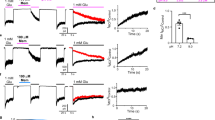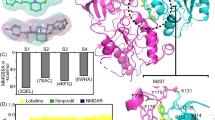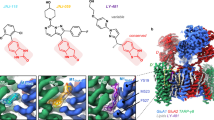Abstract
Excitotoxic neuronal death, associated with neurodegeneration and stroke, is triggered primarily by massive Ca2+ influx arising from overactivation of glutamate receptor channels of the N-methyl-D-aspartate (NMDA) subtype. To search for channel blockers, synthetic combinatorial libraries were assayed for block of agonist-evoked currents by the human NR1-NR2A NMDA receptor subunits expressed in amphibian oocytes. A set of arginine-rich hexapeptides selectively blocked the NMDA receptor channel with IC50, approximately 100 nM, a potency similar to clinically tolerated blockers such as memantine, and only marginally blocked on non-NMDA glutamate receptors. These peptides prevent neuronal cell death elicited by an excitotoxic insult on hippocampal cultures.
This is a preview of subscription content, access via your institution
Access options
Subscribe to this journal
Receive 12 print issues and online access
$209.00 per year
only $17.42 per issue
Buy this article
- Purchase on Springer Link
- Instant access to full article PDF
Prices may be subject to local taxes which are calculated during checkout
Similar content being viewed by others
References
Choi, D.W. and Rothman, S.M. 1990. The role of glutamate neurotoxicity in hypoxic-ischemic neuronal death. Annu. Rev. Neurosci. 13: 171–182.
Choi, D.W. 1995. Calcium: still center-stage in hypoxic-ischemic neuronal death. Trends Neurosci. 18: 58–60.
Nicotera, P., Ankarcrona, M., Bonfoco, E., Orrenius, S. and Lipton, S.A. 1997. Neuronal necrosis and apoptosis: two distinct events induced by exposure to glutamate or oxidative stress. Adv. Neural. 72: 95–101.
Golstein, P. 1997. Controlling cell death. Science 275: 1081–1082.
Snyder, S.H. 1996. No NO prevents parkinsonism. Nature Med.. 2: 965–966.
Dawson, T.M. and Dawson, V.L. 1996. Nitric oxide synthase: role as a transmitter/mediator in the brain and endocrine system. Annu. Rev. Med. 47: 219–227.
Schinder, A.F., Olson, E.C., Spitzer, N.C. and Montal, M. 1996. Mitochondrial dysfunction is a primary event in glutamate neurotoxicity. J. Neurosci. 16: 6125–6133.
Chen, H.-S., Pellegrini, J.W., Aggarwal, S.K., Lei, F.Z., Warach, S., Jensen, R.E. et al. 1992. Open channel block of the N-methyl-D-aspartate (NMDA) responses by memantine: Therapeutic advantage against NMDA receptor-mediated neurotoxicity. J. Neurosci. 12: 4427–4436.
Houghten, R.A., Pinilla, C., Blondelle, S.E., Appel, J.R., Dooley, C.T., Cuervo J.H. et al. 1991. Generation and use of synthetic peptide combinatorial libraries for basic research and drug delivery. Nature 354: 84–86.
Pinilla, C., Appel, J.R., Blanc, P. and Houghten, R.A. 1992. Rapid identification of high affinity peptide ligands using positional scanning synthetic peptide combinatorial libraries. Biotechniques 13: 901–905.
Burnashev, N., Schoepfer, R., Monyer, H., Ruppersberg, J.P., Günther, P., Seeburg, P.M. and Sakmann, B. 1992. Control by asparagine residues of calcium permeability and magnessium blockade in the NMDA receptor. Science 257: 1415–1419.
Wong, E.H., Kemp, J.A., Priestley, T., Knight, A.R., Woodruff, G.N., Iversen, L.L. et al. 1986. The anticonvulsant MK-801 is a potent N-methyl-D-aspartate antagonist. Proc. Natl. Acad. Sci. USA 83: 7104–7108.
Huettner, J.E. and Bean, B.P. 1988. Block of N-methyl-D-aspartate-activated current by the anticonvulsant MK-801: selective binding to open channels. Proc Natl. Acad. Sci. USA 85: 1307–1311.
Premkumar, L.S. and Auerbach, A. 1996. Identification of a high affinity divalent cation binding site near the entrance of the NMDA receptor channel. Neuron 16: 869–880.
Avénet, P., Léonardon, J., Besnard, F., Graham, D., Frost, J., Depoortere, H. et al. 1996. Antagonist properties of the stereoisomers of ifenprodil at NR1A/NR2A and NR1A/NR2B subtypes of the NMDA receptor expressed in Xenopus oocytes. Eur. J. Pharmacol. 296: 209–213.
Mèziére, C., Viguier, M., Dumortier, H., Lo-Man, R., Leclerc, C., Guillet, J.G. et al. 1997. In vivo T helper cell response to retro-inverso peptidomimetics. J. Immunol. 159: 3230–3237.
Li, M. et al. 1996. In vitro selection of peptides acting at a new site of NMDA glutamate receptors. Bio/Technology 14: 986–991.
Steiner, J.P., Hamilton, G.S., Ross, D.T., Valentine, H.L., Guo, H., Connolly, M.A. et al. 1997. Neurotrophic immunophilin ligands stimulate structural and functional recovery in neurodegenerative animal models. Proc. Natl. Acad. Sci. USA 94: 2019–2024.
Hara, H., Friedlander, R.M., Gagliardini, V., Ayata, C., Fink, K., Huang, Z. et al. 1997. Inhibition of interleukin 1β converting enzyme family proteases reduces ischemic and excitotoxic neuronal damage. Proc. Natl. Acad. Sci. USA 94: 2007–2012.
Hunter, A.J. 1997. Calcium antagonists: their role in neuroprotection. Int. Rev. Neurobiol. 40: 95–108.
Lyden, P.D. 1997. GABA and neuroprotection. Int. Rev. Neurobiol. 40: 233–258.
Grilli, M., Pizzi, M., Memo, M. and Spano, P. 1996. Neuroprotection by aspirin and sodium salicylate through blockade of NF-kappa B activation. Science 274: 1383–1385.
McBurney, R.W. 1997. Development of the NMDA ion-channel blocker, aptiganel hydrochloride, as a neuroprotective agent for acute CNS injury. Int. Rev. Neurobiol. 40: 173–195.
Parsons, C.G., Panchenko, V.A., Pinchenko, V.O., Tsyndrenko, A.Y. and Krishtal, O.A. 1996. Comparative patch-clamp studies with freshly dissociated rat hippocampal and striatal neurons on the NMDA receptor antagonistic effects of amantadine and memantine. Eur. J. Neurosci. 8: 446–454.
Herrero, J.F., Headley, P.M. and Parsons, C.G. 1994. Memantine selectively depresses NMDA receptor-mediated responses of rat spinal neurones in vivo. Neurosci. Lett. 165: 37–40.
Vorwerk, C.K., Lipton, S.A., Zurakowski, D., Hyman, B.T., Sabel, B.A., Dreyer, E.B. et al. 1996. Chronic low-dose glutamate is toxic to retinal ganglion cells. Toxicity blocked by memantine. Invest. Ophthalmol. Vis. Sci. 37: 1618–1624.
Kochhar, A., Zivin, J.A., Lyden, P.D. and Mazzarella, V. 1988. Glutamate antagonist therapy reduces neurologic deficits produced by focal central nervous system ischemia. Arch. Neurol. 45: 148–153.
Weseman, W., Sturn, G. and Fünfgeld, E.W. 1980. Distribution and metabolism of the potential anti-Parkinson drug memantine in the human. J. Neural Transm. Suppl. 16: 143–148.
Kornhuber, J. and Weller, M. 1997. Psychotogenicity and N-methyl-D-aspartate receptor antagonism: implications for neuroprotective pharmacotherapy. Biol. Psychiatry 41: 135–144.
Kornhuber, J. and Quack, G. 1995. Cerebrospinal fluid and serum concentrations of the N-methyl-D-aspartate (NMDA) receptor antagonist memantine in man. Neurosci. Lett. 195: 137–139.
Dooley, C.T., Chung, N.N., Wilkes, B.C., Schiller, P.W., Bidlack, J.M., Pasternak, G.W. et al. 1994. An all D-amino acid opioid peptide with central analgesic activity from a combinatorial library. Science 266: 2019–2022.
Houghten, R.A. 1985. General method for the rapid solid-phase synthesis of large numbers of peptides: specificity of antigen-antibody interaction at the level of individual amino acids. Proc. Natl. Acad. Sci. USA 82: 5131–5135.
Ostresh, J.M., Winkle, J.H., Hamashin, V.T. and Houghten, R.A. 1994. Peptide libraries: Determination of relative reaction rates of protected amino acids in competitive couplings. Biopolymers 34: 1681–1689.
Tam, J.P., Heath, W.F. and Merrifield, R.B. 1983. SN2 deprotection of synthetic peptides with a low concentration of HF in dimethyl sulfide: evidence and application in peptide synthesis. Journal of the American Chemical Society 105: 6442–6455.
Houghten, R.A., Bray, M.K., De Graw, S.T. and Kirby, C.J. 1986. Simplified procedure for carrying out simultaneous multiple hydrogen fluoride cleavages of protected peptide resins. Int. J. Pept. Protein Res. 27: 673–678.
Ferrer-Montiel, A.V. and Montal, M. 1994. Structure-function relations in ligand-gated ion channels: Reconstitution in lipid bilayers and heterologous expression in Xenopus oocytes. Methods: A Companion to Methods in Enzymology 6: 60–69.
Ferrer-Montiel, A.V., Sun, W. and Montal, M. 1995. Molecular design of the N-methyl-D-aspartate receptor binding site for phencyclidine and dizolcipine. Proc. Natl. Acad. Sci. USA 92: 8021–8025.
Ferrer-Montiel, A.V., Sun, W. and Montal, M. 1996. A single tryptophan on M2 of glutamate receptor channels confers high permeability to divalent cations. Biophys. J. 71: 749–758.
Sun, W., Ferrer-Montiel, A.V., Schinder, A.F., McPherson, J.P., Evans, G.A., Montal, M. et al. 1992. Molecular cloning, chromosomal mapping, and functional expression of human brain glutamate receptors. Proc. Natl. Acad. Sci. USA 89: 1443–1447.
Planells-Cases, R., Sun, W., Ferrer-Montiel, A.V. and Montal, M. 1993. Molecular cloning, functional expression, and pharmacological characterization of an N-methyl-D-aspartate receptor subunit from human brain. Proc. Natl. Acad. Sci. USA 90: 5057–5061.
Le Bourdelles, B., Wafford, K.A., Kemp, J.A., Marshall, G., Bain, C., Wilcox, A.S. et al. 1994. Cloning, functional expression, and pharmacological characterisation of human cDNAs encoding NMDA receptor NR1 and NR2A subunits. J. Neurochem. 62: 2091–2098.
Author information
Authors and Affiliations
Corresponding author
Rights and permissions
About this article
Cite this article
Ferrer-Montiel, A., Merino, J., Blondelle, S. et al. Selected peptides targeted to the NMDA receptor channel protect neurons from excitotoxic death. Nat Biotechnol 16, 286–291 (1998). https://doi.org/10.1038/nbt0398-286
Received:
Accepted:
Issue Date:
DOI: https://doi.org/10.1038/nbt0398-286
This article is cited by
-
Poly-Arginine Peptide-18 (R18) Reduces Brain Injury and Improves Functional Outcomes in a Nonhuman Primate Stroke Model
Neurotherapeutics (2020)
-
Poly-arginine R18 and R18D (D-enantiomer) peptides reduce infarct volume and improves behavioural outcomes following perinatal hypoxic-ischaemic encephalopathy in the P7 rat
Molecular Brain (2018)
-
The Role of GluN2A in Cerebral Ischemia: Promoting Neuron Death and Survival in the Early Stage and Thereafter
Molecular Neurobiology (2018)
-
Characterisation of neuroprotective efficacy of modified poly-arginine-9 (R9) peptides using a neuronal glutamic acid excitotoxicity model
Molecular and Cellular Biochemistry (2017)
-
The Neuroprotective Peptide Poly-Arginine-12 (R12) Reduces Cell Surface Levels of NMDA NR2B Receptor Subunit in Cortical Neurons; Investigation into the Involvement of Endocytic Mechanisms
Journal of Molecular Neuroscience (2017)



